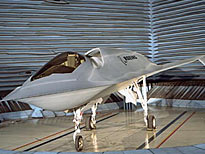
In October 2002, Boeing unveiled the Bird of Prey, a prototype
that was used to demonstrate stealth features and advanced
technologies that could be used on future combat aircraft. The
ultra-secret project formally began in 1992, and Bird of Prey
flew 38 test flights between 1996 and 1999.
|

|
How do you make an aircraft show up on a radar screen looking
as small as a bird or even a large moth, and not like the
lethal, 15-ton machine that it actually is? How do you prevent
heat-seeking missiles from finding and destroying it?
To avoid helping potential enemies develop countermeasures,
many details of stealth are classified. However, the basic
principles are widely known. Select any of the categories
below to find out how engineers can design planes to avoid
detection.
Visual | Radar |
Heat | Noise
|
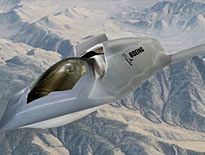
Unlike the B-2 and F-117 in operation today, the light-gray
Bird of Prey prototype was designed to be stealthy enough to
operate in broad daylight. Stabilizers evenly distribute lift
to minimize pressure disturbances and the moisture contrails
they create. A white patch in front of the jet engine intake
helps mask shadows.
|

|
Visual
While it may seem low-tech, the human eye is a powerful
detector. In fact, in some circumstances a pilot may see an
enemy plane before his onboard radar detector picks it up.
Since the earliest days of aerial combat, planes have
traditionally been painted in various types of camouflage in
an attempt to blend into the natural background. Sometimes
camouflage paint on the underside of an aircraft will be
blue-gray, to make the plane appear to blend with the sky for
anyone looking at it from below. For enemy pilots flying
above, the top surface may be gray-green or gray-brown or
sand-colored to match the ground (or sea) below.
In addition, designers can use brighter paint to minimize
shadows cast on the plane by its own wings or other parts.
They can also add specially placed lights to eliminate shadows
or to illuminate the underside of a plane so it appears to
those below to match the brightness of the surrounding sky.
Finally, highly efficient engines can reduce smoke contrails
from the engines, while moisture contrails can be diminished
by inserting additives into the exhaust and by using specially
designed aerodynamic surfaces to minimize pressure
disturbances around the wing.
|
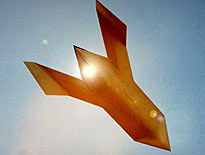
There are only six angles on the Bird of Prey, none of which
is a right angle. The fuselage is rounded in order to scatter
radar in many directions. The engine's air intake, a large
radar target if not properly designed for stealth
considerations, is on the top of the aircraft (to keep it
hidden from ground-based radar) and behind the cockpit (to
hide it from head-on enemy radar).
|

|
Radar
A stealthy plane's shape helps deflect echoes away from radar.
Flat surfaces reflect radar most effectively, so aircraft
designers avoid having any flat parts that are likely to face
in the direction of threat radar on the ground or in planes up
ahead. Right angles return a strong signal back to a radar
detector, so these are avoided. Any angles—for example,
where the wings join the fuselage—are greater or less
than 90 degrees.
Radar hitting a surface such as a wing also creates
electromagnetic waves that travel the length of the wing until
they hit a sharp edge, or "discontinuity." At that point the
waves scatter and may bounce back toward the radar detector.
To send the scatter off in multiple directions and reduce the
strength of the echo, edges are often saw-toothed. Saw-tooth
shapes can be used throughout the plane wherever there might
be discontinuities, such as along the trailing edge of a wing
or at access panels or doors for landing gear or weapons.
The plane's surface can also help minimize radar echoes.
Radar-absorbing materials, often made of fiberglass with
carbon or ferrite particles, can be painted on or applied in
composite skins. When radio waves hit these composites, much
of their energy converts to heat. Sometimes designers add
radar-absorbing structures beneath the skin. Honeycomb-shaped,
these structures cause radar to bounce around inside the
plane, dissipating energy with each bounce.
|
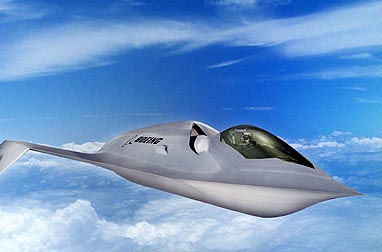
The Bird of Prey's engine intake is situated behind the
cockpit, hiding its thermal signature from ground-launched
missiles or thermal-imaging devices.
|

|
Heat
To avoid detection by thermal imaging devices or targeting by
heat-seeking missiles, stealthy aircraft must minimize heat
emissions. A major source of such infrared emissions is the
engine exhaust. Engine intakes and exhausts can be mounted
above the wings, lessening the chance that heat-seeking
missiles shot from below will detect them. However, these
masked features adversely affect aircraft maneuverability, so
high-performance fighters like the F/A-22 and the X-35 JSF,
which require excellent air combat capability, have their
inlets and exhausts located more traditionally.
Engineers also design exhaust nozzles so that hot engine
exhaust gases mix almost instantaneously with cold air
surrounding the plane. Another source of heat is air friction
caused by travel at very fast speeds, an effect that is
particularly pronounced at the wing's leading edge. By pumping
cool jet fuel inside the wing around the leading edge, this
heat signature can be minimized. Sunlight glinting off the
wings is another source of infrared radiation. It can be
reduced through the use of IR-absorbing paints.
|
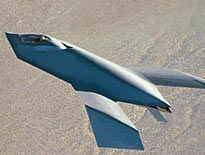
The Bird of Prey is a prototype stealth technology
demonstrator designed mainly to avoid radar and visual
detection. But it is also quieter than other fighters. Its
maximum speed is only 300 miles per hour, well below the
supersonic level.
|

|
Noise
Engines are an aircraft's major source of noise. Placing them
on top of the airplane lessens the sound heard on the ground.
In addition, great attention is paid to designing quiet
engines. Traditional turbojets take a small amount of air and
then shoot it out the back at very high speeds to create
thrust, which is noisy. Both stealth aircraft and newer
commercial planes, on the other hand, use a high bypass
turbofan engine, which creates just as much if not more thrust
by taking in a much higher volume of air but accelerating it
less. The extra air also creates a cushion around the engine,
which helps to dampen the sound. In addition, stealthy
aircraft may be designed to fly only at subsonic speeds, so as
to preclude the telltale sonic boom. However, higher
performance stealth aircraft, like the F/A-22 and X-35, are
designed to balance the tradeoffs between extreme stealth and
excellent air combat performance (as measured by supersonic
speed and exceptional maneuverability). These stealthy
aircraft are therefore also capable of supersonic performance,
and in the case of the F/A-22, of supercruise performance at
very high altitudes.

|

|
|

